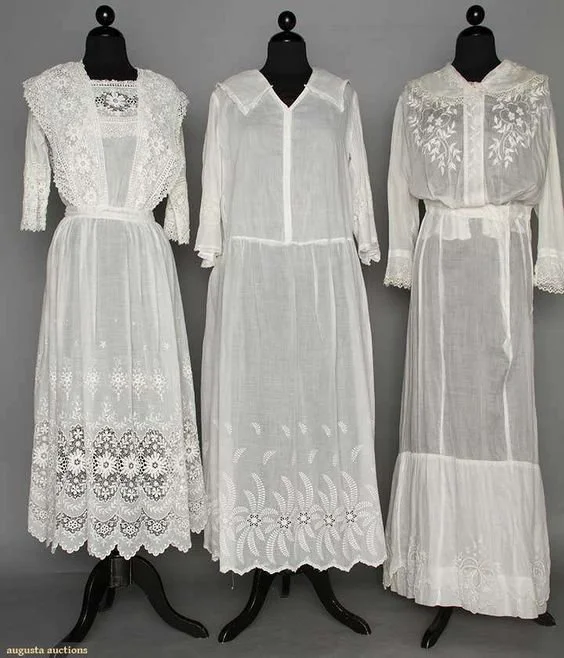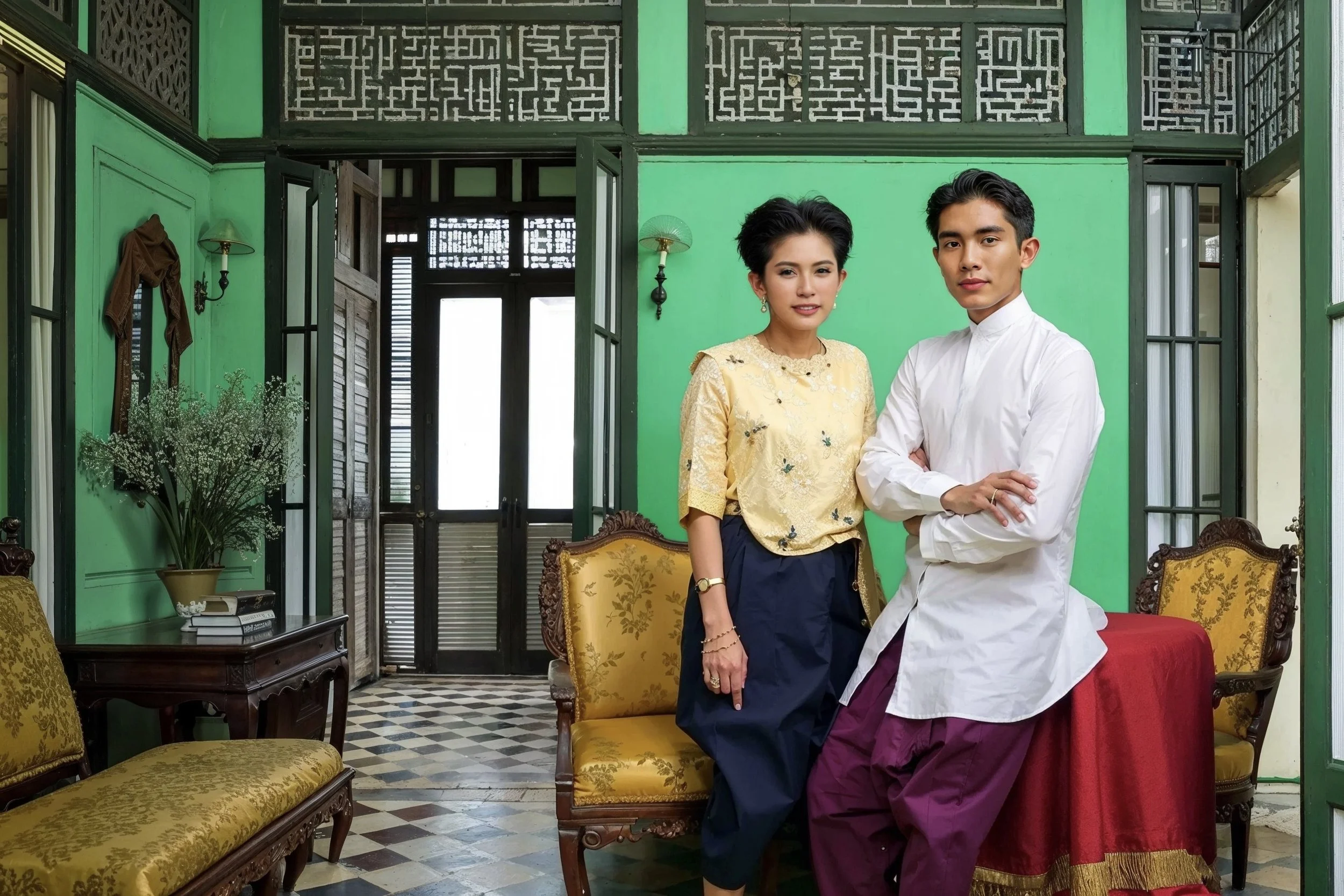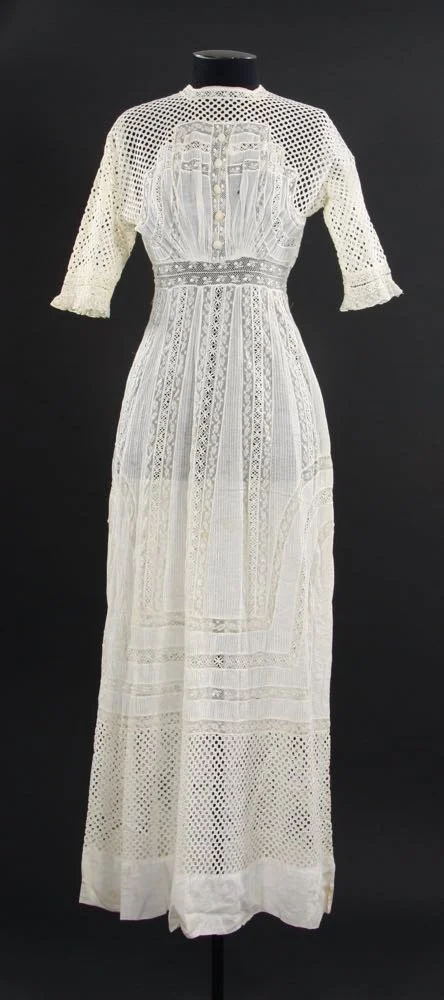เสื้อเบลาวส์สไตล์เสื้อลองเจอรีในสยาม (Lingerie Blouses): อิทธิพลจากสไตล์เอ็ดเวิร์ดเดียนและการประยุกต์ใช้ในสมัยรัชกาลที่ ๖
เสื้อเบลาวส์สไตล์เสื้อลองเจอรีในสยาม (Lingerie Blouses): อิทธิพลจากสไตล์เอ็ดเวิร์ดเดียนและการประยุกต์ใช้ในสมัยรัชกาลที่ ๖
ในช่วงต้นคริสต์ศตวรรษที่ ๒๐ แฟชั่นสตรีในยุโรปเริ่มเปลี่ยนแปลงจากความเป็นทางการและเข้มงวดในการแต่งตัวในยุควิกตอเรีย ไปสู่ความอ่อนช้อยและโปร่งเบามากขึ้น เสื้อผ้าทรงแข็งและคอตั้งได้รับช่วงต่อด้วยเสื้อเบาบาง คอกว้าง แขนสามส่วน ตกแต่งด้วยลูกไม้และจีบเล็ก ๆ อย่างประณีต หนึ่งในรูปแบบที่ได้รับความนิยมสูงสุดคือ ลองเจอรีบลาวส์ (lingerie blouse) ซึ่งมักตัดเย็บด้วยผ้าฝ้าย ผ้ามัสลิน หรือผ้าลินิน—all เป็นผ้าที่มีเนื้อบางเบา ระบายอากาศได้ดี และสวมใส่สบาย เหมาะสำหรับภูมิอากาศร้อนในช่วงฤดูร้อนของยุโรป
ด้วยคุณสมบัติเหล่านี้ เสื้อหรือชุดประเภทนี้จึงได้รับความนิยมอย่างยิ่งเมื่อเข้าสู่สยาม โดยเฉพาะในช่วงปลายรัชกาลที่ ๕ ถึงต้นรัชกาลที่ ๖ ที่ซึ่งชนชั้นสูงเริ่มเปิดรับวัฒนธรรมตะวันตกมากขึ้น เสื้อเบลาวส์สไตล์เสื้อลองเจอรีซึ่งมีลักษณะโปร่งเบา ตกแต่งลูกไม้และจีบเล็ก ๆ จึงเข้ากันได้อย่างกลมกลืนกับทั้งสภาพภูมิอากาศ และแนวโน้มการแต่งกายของสตรีไทยในยุคเปลี่ยนผ่านเข้าสู่ความเป็นสมัยใหม่
แม้จะรับอิทธิพลจากยุโรป แต่สตรีไทยมิได้นำเสื้อฝรั่งมาใช้อย่างตรงตัว หากแต่ปรับให้เข้ากับบริบทท้องถิ่น โดยจับคู่เสื้อเบลาวส์สไตล์เสื้อลองเจอรีเข้ากับ “โจงกระเบน” ผ้านุ่งแบบไทยที่พันรอบตัวแทนการนุ่งซิ่นตามวิถีไทยดั้งเดิม การผสมผสานนี้สร้างเอกลักษณ์ใหม่ทางแฟชั่นที่งดงามและร่วมสมัย ทั้งยังสะท้อนถึงความสามารถในการปรับตัวของสตรีไทยที่สามารถรับเอาแนวคิดตะวันตกมาผสมกลมกลืนกับอัตลักษณ์ดั้งเดิมได้อย่างสง่างาม
ทรงผมก็มีบทบาทสำคัญในภาพลักษณ์นี้ หญิงไทยในยุคนั้นนิยมตัดผมสั้นตั้งแต่สมัยต้นกรุงรัตนโกสินทร์ โดยเฉพาะทรง “ดอกกระทุ่ม” ที่ดูแลง่าย เย็นสบาย และเข้ากับเสื้อลินเจอรีที่เปิดคอและต้นคออย่างลงตัว ผมทรงสั้นยังช่วยขับเน้นรายละเอียดของคอเสื้อและลูกไม้ให้โดดเด่นยิ่งขึ้น
คอลเลกชันภาพ AI นี้ได้รับแรงบันดาลใจจากบรรยากาศทางวัฒนธรรมและแฟชั่นในช่วงรัชกาลที่ ๖ โดยถ่ายทอดภาพคู่รักแต่งกายในสไตล์ไทยผสมตะวันตก ฉากหลังเป็นบ้านไม้สไตล์โคโลเนียลที่ทาผนังสีเขียว ซึ่งเป็นโทนสีที่นิยมใช้ในบ้านของชาวต่างชาติหรือขุนนางในยุคอาณานิคม เนื่องจากให้ความรู้สึกเย็นตาและเหมาะกับภูมิอากาศเขตร้อน ฝ่ายหญิงสวมเสื้อลองเจอรีบลาวส์ลูกไม้แบบฝรั่ง คู่กับโจงกระเบนไหมและเครื่องประดับทองแบบดั้งเดิม ขณะที่ฝ่ายชายแต่งกายด้วยเสื้อราชปะแตนหรือเครื่องแบบข้าราชการในยุคนั้น
ทั้งนี้ คำว่า “ลองเจอรีบลาวส์” (lingerie blouse) อาจทำให้ผู้อ่านบางท่านเข้าใจผิดว่าเป็น “เสื้อชั้นใน” เนื่องจากคำว่า lingerie ในภาษาอังกฤษร่วมสมัยมักหมายถึงชุดชั้นในของสตรี อย่างไรก็ตาม ในบริบทของแฟชั่นต้นคริสต์ศตวรรษที่ ๒๐ คำนี้หมายถึงเสื้อหรือชุดที่มีลักษณะบางเบา เย็บจากผ้าฝ้าย มัสลิน หรือผ้าลินิน ตกแต่งด้วยลูกไม้และจีบเล็ก ๆ ซึ่งล้วนเป็นเทคนิคที่เคยใช้ในชุดชั้นในโบราณ แต่ต่อมานำมาดัดแปลงใช้กับเสื้อผ้าชั้นนอกที่ใส่ได้ในชีวิตประจำวัน โดยเฉพาะในฤดูร้อน จึงขอย้ำว่าเสื้อลองเจอรีบลาวส์ในบริบทของบทความนี้ มิใช่ชุดชั้นใน หากแต่เป็นเสื้อฝรั่งแบบเบาบางที่สะท้อนความงดงามของยุคเอ็ดเวิร์ดเดียน และถูกสตรีไทยนำมาประยุกต์ใช้อย่างงดงามในฐานะเสื้อใส่กลางวันในชีวิตจริง
เสื้อเบลาวส์สไตล์เสื้อลองเจอรีในบริบทของสยามจึงมิใช่เพียงเครื่องแต่งกาย หากแต่เป็นสัญลักษณ์ของการประสานวัฒนธรรมตะวันตกกับรากเหง้าไทยอย่างละเมียดละไม เป็นการแสดงออกถึงการเข้าสู่ความทันสมัยโดยไม่ละทิ้งความเป็นไทย ความโปร่งเบาของผ้า ความประณีตของลวดลาย และการเลือกจับคู่กับโจงกระเบนไทย ล้วนสะท้อนถึงรสนิยมของสตรีไทยชั้นสูงที่มีความมั่นใจในอัตลักษณ์ของตน
ในท้ายที่สุด ลองเจอรีบลาวส์จึงไม่ใช่เพียงเสื้อฝรั่งหรูหรา หากแต่เป็นหน้าต่างที่สะท้อนให้เห็นถึงช่วงเวลาสำคัญในประวัติศาสตร์แฟชั่นไทย ที่สตรีไทยสามารถผสานความงดงามจากสองโลกไว้ได้อย่างงดงามและกลมกลืน
Lingerie Blouses in Siam: Edwardian Influence during the reign of King Rama VI
In the early 20th century, women’s fashion in Europe underwent a significant transformation. The highly structured, high-necked garments of the Victorian era gave way to lighter, more relaxed designs characterised by lace-trimmed blouses, airy fabrics, and soft silhouettes. Among the most emblematic styles of this transitional period was the lingerie dress, a delicate, white or pastel-coloured day dress made of cotton, muslin, or fine linen. These garments, known for their pintucks, lace insertions, embroidery, and sheer textures, were originally inspired by techniques used in undergarments—hence the name "lingerie." They offered an ideal solution for hot summer climates and gained widespread popularity between 1900 and 1925, particularly across the United States, the United Kingdom, and European colonies in Asia.
In Siam, the influence of Edwardian fashion was embraced with thoughtful adaptation rather than mere imitation. Rather than adopting full European ensembles, Siamese women blended Western lingerie blouses with traditional Thai garments, particularly the chong kraben, a wrapped lower garment that allowed ease of movement and breathability. This hybrid style created a unique visual language that reflected both cosmopolitan modernity and Thai cultural heritage. The soft fabrics and delicate embroidery of the lingerie blouse complemented the richly coloured silk of the chong kraben, while the cropped length of the blouse helped emphasise the intricate pleating and draping of the lower garment.
An important factor in the success of this fusion was the long-standing tradition of short hairstyles among Siamese women. Unlike their European counterparts—who often styled their hair in elaborate updos—Siamese women had worn short hair since the early Rattanakosin era. The popular Dok Krathum style, resembling a soft, rounded bob, became the perfect complement to the lightness of the lingerie blouse. It created a modern, elegant silhouette that was both climate-appropriate and culturally resonant.
This adaptation of the lingerie blouse into Thai fashion coincided with the reign of King Vajiravudh (Rama VI, 1910–1925), a period marked by the expansion of Western influence in education, art, and dress. Women of the Siamese elite, many of whom had received Western-style education or had ties to the royal court, became the early adopters of this blended fashion. Photographs and illustrations from this era depict women wearing translucent, lace-trimmed blouses with mid-length sleeves and low, rounded necklines, paired with chong kraben and accessorised with traditional gold jewellery. These outfits were often worn in colonial-style homes—many painted in shades of green, a colour popular in tropical architecture due to its cooling visual effect—highlighting the intersection of Western domestic influence and Thai aesthetics.
The AI-enhanced fashion portraits in this collection aim to recreate and reimagine that cultural moment. Set against period-appropriate colonial interiors, the imagery captures couples dressed in early 20th-century Thai-European hybrid styles. The women’s blouses, based on authentic lingerie dress designs, float softly over jewel-toned chong kraben, their necklines framed by short hairstyles and delicate jewellery. Meanwhile, the men wear crisp, white raj-pattern jackets and military-style coats that evoke the formality and refinement of the Rama VI court.
Lingerie dresses and blouses remained a popular choice throughout the 1910s and into the early 1920s, gradually evolving alongside the modernisation of Thai society. They offered not only a fashionable silhouette but also a practical response to the tropical heat of Siam. Their popularity signalled a moment of cultural fusion in which European design principles were thoughtfully adapted to local needs, both climatic and aesthetic.
The term “lingerie blouse” may cause some confusion, as the word lingerie in modern English often refers to women's undergarments. However, in the context of early 20th-century fashion, a lingerie blouse was not an undergarment. Rather, it referred to a lightweight, outerwear blouse made from fine cotton, muslin, or linen, often decorated with lace, pintucks, and delicate embroidery. These embellishment techniques were originally associated with historical lingerie and underpinnings, which is why the term was adopted. Nevertheless, these blouses were designed to be worn publicly, especially in warm weather, as elegant daytime attire. It is important to clarify that in this article, lingerie blouses are not underwear, but refined outer garments influenced by Edwardian aesthetics and gracefully adapted into Thai women's wardrobes during the early 20th century.
Ultimately, the adaptation of lingerie dresses in Siam tells a larger story about the intersection of tradition and modernity. While the garments themselves were rooted in European fashion trends, the way they were worn in Siam—paired with traditional garments, hairstyles, and jewellery—ensured that they became part of a uniquely Thai visual language. The result was a graceful yet modern look that defined an era of quiet cultural confidence among Siamese women at the dawn of the 20th century.
#aifashionlab #AI #aiartist #aiart #aifashion #aifashiondesign #aifashionstyling #aifashiondesigner #fashion #fashionhistory #historyoffashion #fashionstyling #fashionphotography #digitalfashion #digitalfashiondesign #digitalcostumedesign #digitaldesign #digitalaiart #ThaiFashionHistory #ThaiFashionAI #thailand #UNESCO








































